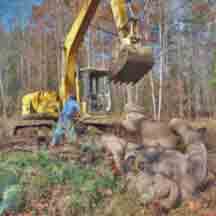Summer of 2009 was very rainy in Maine. Progress was also slowed down by the difficult, existing site conditions. Ground work was largely completed and work will continue as conditions may permit. The original, February 2009 plans have been moved to this page and now appear below.
I finally cleaned-up my 3D plans, after reflecting on detail options for months. Here then is my December 2009 version plans. (My 2008 version remains intact below, on this same page).
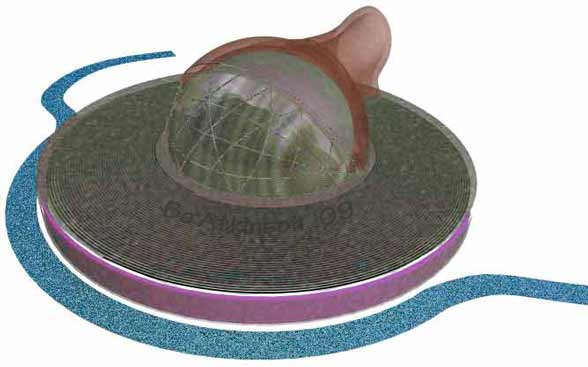
Existing, seasonal stream (blue color) has been land-sculpted to 'warm' the perimeter during extremely cold seasons. (Keeps perimeter ground closer to thaw temperature). Insulation is purple or magenta. A solar collector embedded in ferro-cement covers the ground insulation.
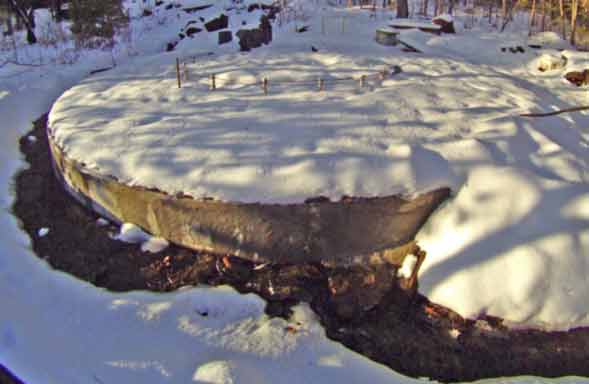
Site as of December 2009.
If this looks to difficult, here is my ultra cheap, solar, planter's wigwam, instead.
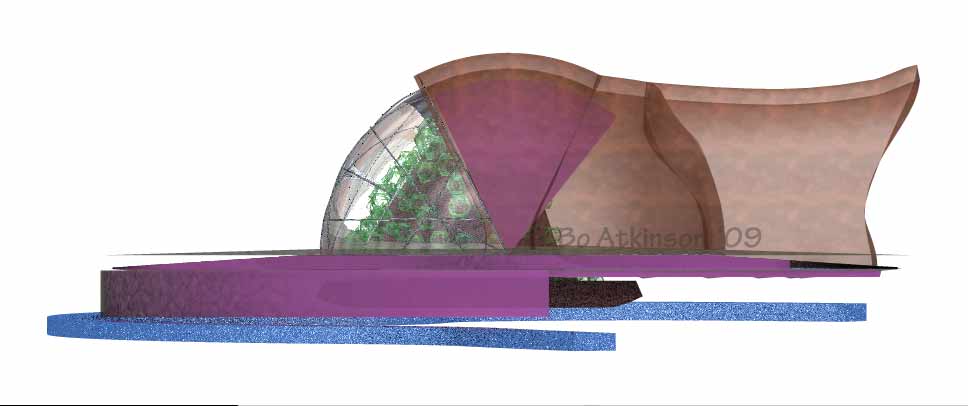
Side view of eyelid dome shows the insulating 'eyelid' fully lifted for daylight absorption. Actually, my 2010 plans reduce the entry size. The plastic 'eyelid' can also hinge up during warm seasons.
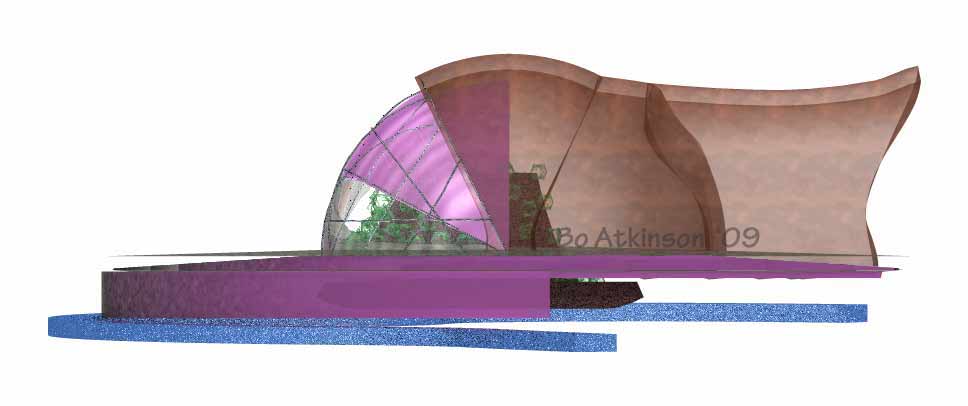

Half open or closed insulating eyelid. Fully closed lid. Following is the 2008 stage of planning for this project.
~~~~~~~
Actual Construction and testing had been planned for summer of 2009 (Maine, USA)-- First drawings done in Feb 09 (plans) follow below: Insulating eyelid is shut closed, for winter time or very cold nights. The insulating foam-board eyelids hinge on the dome axis. The sun-shaded side (usually to the north) is thin shell ferrocement for durability (though many composite materials can be considered for reasons like "green re-use of surplus materials, much as "LEEDS" and other conventions promote).
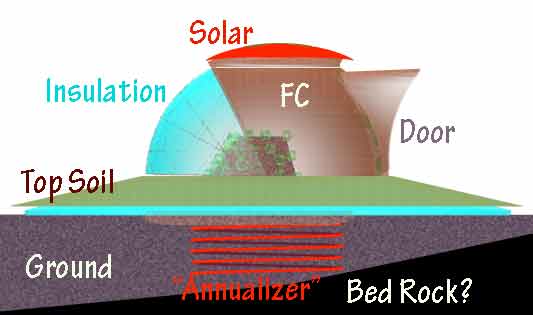
Can it be powered by a garden hose? By winter 2010, it is hoped some preliminary results will be reported. Minimal water pumping through a garden hose should power this the HVAC-like features, without further equipment or energy costs. Next below is pictured the styrofoam (or equivalent) eyelid hinged up to allow sunlight entry. (The light blue color is used schematically, in this set of pictures, unlike other of my web pages). The general dome or a semi-spherical shape is recommended for maximum efficiency in material use and because the human eye is a wonderful model to copy from. Open your eyes:
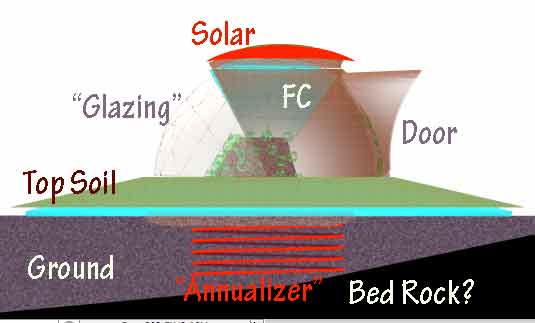
The red top signifies a solar collector made of low cost PE tubing. (It is usually black colored plastic in real life and would be embedded within a ferrocement layer "FC"). Summer solar heat is annualized in the ground through competitively powered, trickle down flow. Water based solar is suggested here to deliver heat to the "solar annualizer", located underground. That is, to a heat exchanger in this "trickle down solar system". A slightly domed and oval spiral path collector of PE tubing will allow gravity-drainage for winter, next picture below. Spiral solar Collector--
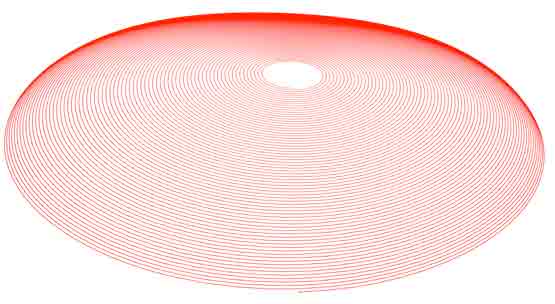
Next below is pictured a very wide angle view with insulation-eyelid raised for daytime sun. The glazing has been pictured translucent (yet best pricing is found with translucent plastic sheeting). A framework made of steel bar is recommended. In fact steel reinforcement "rebar" is suggested as it generally costs much less than smooth bar, for a given size. This perhaps due to respective market supply and demand.
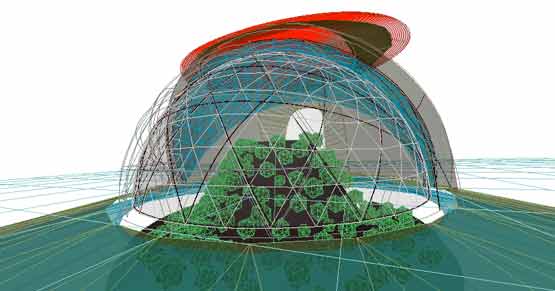
The next picture below displays profile with grid and rulers (with computer accuracy throughout this mode, done in formZ). The solar collector extends beyond the dome profile (as drawn). I also have modeled a "bare bones" version where the bulk material is entirely insulation material with the solar collector inside the dome and where the "eyelids" open wider than a 100º. Money savings are likely but personally i prefer having closed surface features made stronger with ferrocement, (to resist greater winds, fire, hail, and general damage Also to provide further options like bug screens and partial sun shading.)
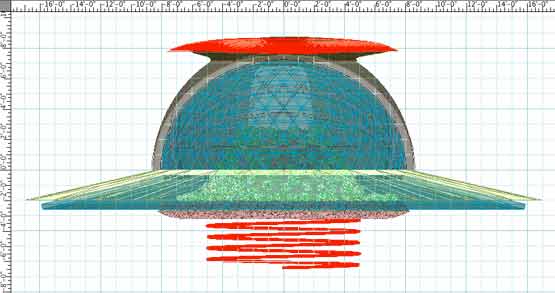
Next picture below pulls the essential components apart. Not yet schematically shown here as yet, is the a third eyelid framework with a pest-screen. Growers have also benefited from screens in terms of selective pollination. All "eyelids" can be hinged up for any chore or for direct sunlight options. Also, "solar openers" can be used for automating eyelid control. Furthermore, solar, thermal water valves can automate the heat storage cycle. Thermal piston technology is expanding today and is much simpler than electronic controls which require external power systems. BTW, the most common thermal piston valve is the old thermostat used in automobile engines.
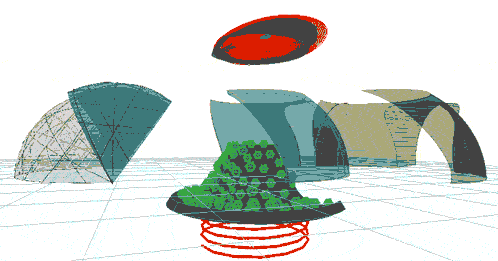
If people email me asking for details on my "trickle down solar" i will then be inspired to work on more schematic diagrams (for the web). The red "annualizer" diagramed earlier, could be closed loop for water conservation,. Or in Maine, my thought is to simply trickle into the soil, which usually has high water tables in the soil. I work as a micro contractor and sometimes cannot respond to email requests immediately. In the mean time, here is a schematic drawing done on my first computer in 1992, (off-hand recollection). I've been using various aspects of this concept since the 1970's for domestic hot water. However, good thermal valves are expensive and just using a shutoff valve daily can suffice-- When daily memory serves well.
Another simplified version version is illustrated next: A minimalist-eyelid dome would cost less and have fewer amenities. Three states for opening the minimalist eye lids are schematically portrayed, (picture below). (An optional entry-awning is drawn in gray color.)

Left: All lids are closed for cold nights, (3 colors differentiate the three individual eyelids, made primarily of structural foam insulation). Center: One eyelid is open, but with framework for plastic glazing now revealed, for cold daytime growing. Right: All three eyelids are contracted for open air exposure in summer. Next below is shown an option for heating solar water which also shades excessively hot noontime sun:
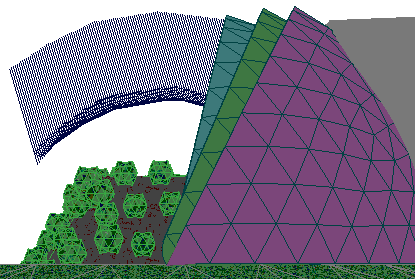
A solar visor made of plastic solar tubing could be supported with a "ceiling framework", (framework not shown). The solar visor should somewhat help shade the space under hot summer sun and at the same time gather heat to trickle down into the "annualizer" heat storage. Cost may be kept low by use of rebar framework and PE tubing with a thermostatic-valve for automatic on-off, (with commercial valves available at many temperature settings). These valves are very similar in performance to the universal types found in all auto & truck engines with a difference only in temperature setting. So where would solar heated water go? The next illustration schematically shows the essential components for a "trickle-down solar annualization of heat storage".
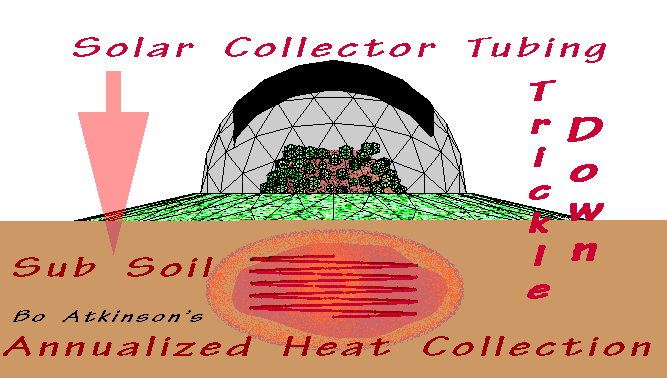
By use of plentiful on-site ground water, (within water rich regions), the hot water could trickle into a "dry well" patch of gravel or sand beneath the growing bed-- Yet far enough below the growing bed to not increase summer soil temperature much above it's otherwise normal summer temperature range. By Autumn, the soil temperature would be reaching warmer stability for benefits in cooler seasons. Thereby warmer climate conditions can be emulated during cooler seasons, without use of fuel for heat. In the first model example of this web page, heat collection from the solar collector on top could store heat similarly, with the more greenhouse amenities. With proper research, preferable depths for heat storage can be found-- Heated water could quickly deliver the heat downward by gravity flow alone, which otherwise takes more electrical power if air delivery is used. Fresh water would be cold ground water, such as pressurized well water. Since water purity is maintained throughout, there is absolutely no pollutant trickled into the ground. Only heat is delivered into the sub soil ground. The heated water should first flow to the lowest point of an "annualizer", if used-- Thereby, summer time soil temperatures should generally remain normal. It is my intention to try such a scheme.More of my general study of self heating concepts can be viewed here.
There are precedents of using aquifers and huge cisterns quarried out of bedrock, (to be found in Europe and Scandinavia). Here is one graphic example i just now googled:
Source: zonneterp.nl Despite the technically-advanced thinking behind Zonneterp, a question still remains, as to which system in the world of markets, will produce more photosynthesis per unit of cost? Where can cost be saved and grower earnings ameliorated?
My guiding principle is "zero energy" (or a greenhouse ability to function without energy inputs like fuel, to be "off-grid-ready" in essence, except perhaps by use of a pressurized garden hose. To keep it simpler than going into auxiliary system investments. To provide good functionality. Keep it bare bones, low cost, whether sold as a kit or "do-it-yourself-creation-from-scratch". Even encourage a serious developer to market it and market upgrade packages towards systems as complex as Zonneterp. Or to market it along with other green house systems, at any scale.
My earlier and first Eyelid Greenhouse page lives here.
Detailed 3D modeling keeps me busy in cold winter periods, planning for warmer-weather, physical work. I offer concepts for free, when inspired to to do so. Write to me, boa1@pivot.net with challenging needs. Or if you want your own personalized needs modeled by me privately, my rates are adjustable to meet specific circumstances. I'm fairly happy with nominal rates offered, but actually need to make a living and pay for expensive software and hardware. I am increasingly able to live on smaller budgets and never even acquired real credit, in modern banking terms. In fact, i have worked with high standards of responsibility for decades, apparently something bankers do not appreciate. I am primarily self educated and spend lots of time improving my many integrated skills. Do consider my service for that big or small project.
Updating of this page will continue as time permits and as building proceeds. I ruffed out my eyelid greenhouse building site in 2008, with a huge excavator. Consider hiring me for earth work! I love land-sculpting by use of huge excavators. I have studied and worked with varied organic gardening principles since the early 1970's. I offer computer accurate "cut and fill" modeling skills at very low cost, even through email. So the plans can be rendered with "photo-realism", if a client wishes to see "landscape as sculpture" before it is landscaped or before any earth is moved. I can rent huge excavators for your project and contract it to your specifications. To build a symbol, hire a sculptor.
See my pictorial portfolio without text, for many integrated kinds of creative work.
or
See my similar thumbnail portfolio with text captions underneath each picture...
Blog On Patents
Why not patent a great idea? Well, as a kid i wanted to patent inventions, as my elders had suggested this. It was a first-cousin of my father, Duane Atkinson, who invented that beeper on big construction equipment, (back in the 50's, or so). Every time i hear big equipment backing up, with that "beep-beep-beeb", i think of Duane. I was so proud and inspired as a small kid! I wanted to work for him at GFACO. He recommended i buy my first cheap Heathkit, an electronic voltammeter. I just loved technology, but as many kids grow up to find out, it is very difficult to patent anything as a low income individual. (I 've been low income and self employed for my whole adult life. The silver lining was that plenty of time was available to visualize and actualize and to self-educate through many resources). Instead of college, i moved to NYC in 1967and enjoyed studied at the US Patent Library, on the west side. Yet, as they say: "it is not what you know, but rather who you know". Heh, heh. Besides that, there are many woes in life. I love to collaborate and cooperate nonetheless. If you want to invent something together with me, write. If we can't pay for the endless legal process, we might at least publish it on a web page along with citations and credits, where due. We will at least secure the legal right to personally use the invention or share it with society. Make money at it? Fine, "show me the money" ;-) as the comedian once said. Yet it is immediately rewarding to share one's ideas on the internet, freely, in the "open source" fashion. Peace & Good Will

